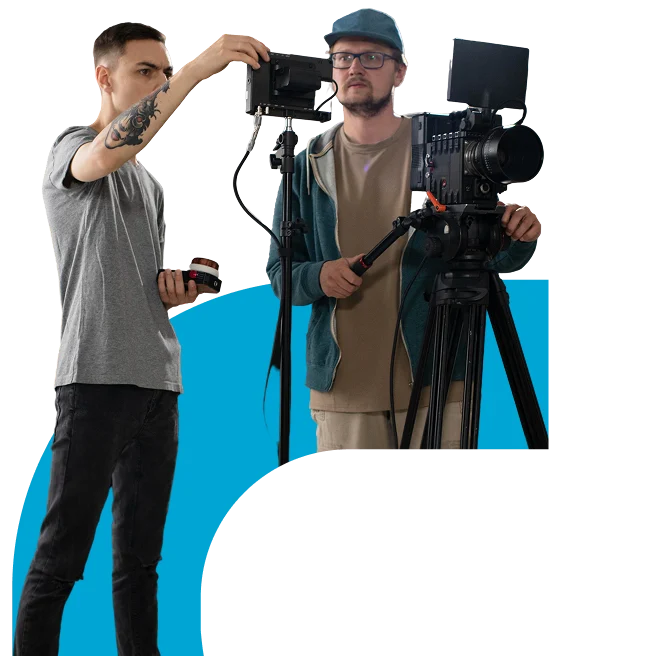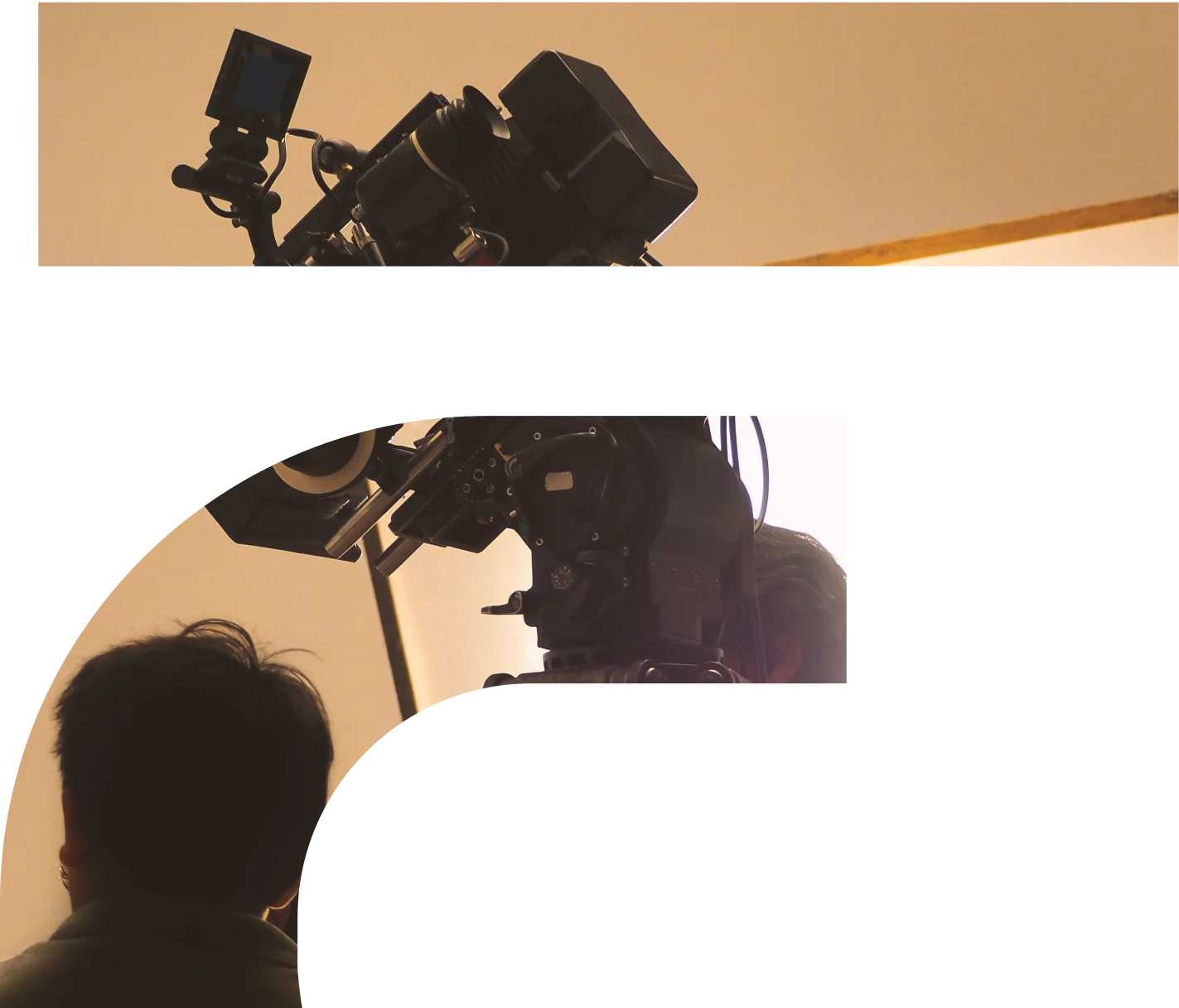GRIP
A grip is a versatile role responsible for various tasks to ensure the smooth operation of equipment and help bring the director’s vision to life.
On a film set, a grip is a crucial behind-the-scenes role that deals with all things related to supporting and moving equipment. Like a roadie for a touring musical act, they are responsible for setting up and adjusting the gear that helps make the movie magic happen.
Grips handle various tools like C-stands, clamps, and rigging equipment, creating the right environment for cameras and lights to do their job. Think of a grip as the "fixer-upper" on set – they're there to problem-solve and ensure that everything stays in place. For instance, if a scene requires a camera to smoothly glide along a track or if a light needs to be perfectly positioned, it's the grip's expertise that makes it happen.
They work closely with the camera department, lighting crew, and sometimes even the special effects team to achieve the director's vision. They help turn a director's creative ideas into practical, visually stunning scenes by maneuvering the equipment with precision and skill. Without grips, capturing those captivating shots and scenes in movies and TV shows would be much more challenging.
In essence, a grip is a hands-on professional who plays a crucial role in the practical aspects of filmmaking, facilitating the technical aspects of camera work, lighting, and overall set functionality. Their adaptability and technical skills make them essential contributors to the production process.


On a film set, a grip is a versatile role responsible for various tasks to ensure the smooth operation of equipment and help bring the director's vision to life. Think of a grip as the hands-on expert behind the scenes, making everything work seamlessly. They work as part of a crew that works closely with the cinematographer but may be called in for other work, too.
Grips handle the assembly and positioning of essential production equipment, such as cameras, lights, and supports like tripods. They assist in creating dynamic camera movements by setting up tracks, dollies, cranes, and other systems to achieve smooth and controlled shots. Grips are also responsible for securing equipment properly and moving heavy equipment from one location to another.
Grips collaborate with the lighting department to set up and adjust light fixtures, using various tools like C-stands and flags to control and shape the light. They are skilled in rigging, which involves securely mounting cameras, lights, and other equipment to achieve specific angles or movements.
Grips might be involved in adjusting set elements to accommodate technical requirements, ensuring that everything aligns for a seamless shoot. This could entail building scaffolding that holds lighting, parts of a set, or audio equipment. Grips often encounter challenges that require quick thinking and problem-solving skills to ensure that the shoot progresses smoothly.
Becoming a grip on a film set typically involves a combination of practical experience, networking, and a willingness to learn on the job. While formal education isn't always a requirement, gaining basic knowledge of film production through workshops, online courses, or community college classes can be beneficial.
Look for entry-level positions or internships on film sets. This could include roles like a production assistant, where you can observe and learn from experienced grips and other crew members. Develop practical skills by working with equipment commonly used on film sets. Learn to assemble and move cameras, set up lights, and understand the basics of rigging.
Connect with professionals in the industry, especially grips and other crew members, by attending local film events, join online forums, and looking for mentors. Express your interest in becoming a grip to those you've connected with–many grips start as production assistants or assistants to established grips, gradually learning the ropes while on set.
Familiarize yourself with the various tools and equipment grips use, such as C-stands, clamps, and rigging materials. Understanding the gear is crucial for effective collaboration on set. As you gain experience, document your work and create a portfolio showcasing your contributions to film projects. This can serve as a visual representation of your skills and dedication.

Generally speaking, you typically don’t need a formal degree to become a grip on a film set. Many successful grips have entered the industry through practical experience and on-the-job learning. While a high school education is often sufficient, gaining relevant skills and knowledge is more important than getting a degree.
Hands-on experience is highly valued in the film industry, and many grips start as production assistants or in entry-level positions, gradually working their way up through practical exposure to the equipment and processes used on sets. Workshops, seminars, or online courses related to film production can provide foundational knowledge and enhance your skill set, but rolling up your sleeves and getting the work done is where you’ll learn the most.
Networking is also key because building connections with professionals already working in the industry, especially grips and other crew members, can open doors to opportunities and mentorship. You can learn from them and, if you’re responsible and really show that you’re interested in the work, they will remember your name when jobs come up.
What matters most in the film industry is your ability to demonstrate competence, reliability, and a strong work ethic. Grips need technical proficiency in handling equipment, problem-solving skills, and the ability to work efficiently in a collaborative environment–and you just won’t get that experience in a classroom.
As a grip, you need to be a bit of a Swiss army knife, knowing enough about a lot of aspects of the filmmaking process. You need to develop hands-on skills in handling film equipment, such as cameras, lights, and rigging tools and understanding the mechanics of various gear used on set is essential.
And you need to be able to pull your weight–no pun intended. While this isn’t necessarily a skill, grips often engage in physically demanding tasks, including lifting heavy equipment and setting up rigging. Building physical strength and stamina is important for the role. There’s also a cerebral side of being grip: you’ll encounter various challenges on set, and the ability to think on your feet and find practical solutions is invaluable.
Grips collaborate closely with other crew members, such as camera operators and lighting technicians. Clear communication and teamwork are essential for a smooth production process, so whether you’re taking orders from the director, cinematographer, or other above the line people, you need to be able to digest the information and follow through,
You need to be adaptable to different working conditions and environments. Film sets can vary widely, and the ability to adjust to changing circumstances is a valuable skill for a grip. And above all, prioritize safety. Grips are responsible for securing equipment properly to prevent accidents on set. Being safety-conscious and following industry guidelines is crucial.
Becoming a grip on a film set is definitely achievable through a combination of hands-on experience, networking, and self-education. Yes, there may be even some formal education courses you can take for the technical aspects of the job. But in most cases, you’ll need to dive right into the local film community.
Look for internships or entry-level positions in film production companies or rental houses that specialize in film equipment. These opportunities can provide hands-on experience and exposure to industry tools. Start by working as a production assistant (PA) to gain exposure to the film industry.
While on set, observe the work of grips and express your interest in learning the trade. Offer to assist them and learn from their experience. Connect with professionals in the film industry, especially grips, by attending industry events, workshops, and film festivals to build relationships. Networking can open doors to opportunities and mentorship.
You can also go online to learn more about what a grip does through online tutorials, videos, and other resources. Books and manuals on grip techniques and film production will give you a theoretical understanding of the equipment and techniques that will enhance your skills. Combining these approaches will give you a well-rounded foundation to become a grip on a film set–but dedication, enthusiasm, and a willingness to learn are key elements for success as a grip.
The timeline for becoming a grip can vary depending on your dedication, available opportunities, and any experience you may have working with film equipment, construction, and other hands-on experience. If you’re handy and live in an area where filmmaking or production is robust, you will be able to find work much faster.
Generally, it may take several months to a few years to establish yourself in the industry. If you are proactive and network effectively, you might secure entry-level positions or internships relatively quickly. These opportunities can provide hands-on experience and introduce you to the basics of the job.
Gaining proficiency as a grip involves mastering various techniques, understanding equipment, and ensuring safety on set. The learning curve depends on how quickly you can absorb and apply this knowledge, and how much practical experience you have access to. Some individuals may grasp the essentials in a few months, while others may take longer.
The time it takes to establish meaningful connections and relationships with experienced grips and filmmakers can influence your progress. Attending events, joining local film communities, and participating in projects can expedite this process. The film industry is dynamic, with new technologies and techniques emerging regularly.
Being a grip is an ongoing learning process–continuous education through online resources, workshops, and on-the-job experiences will contribute to your growth. Advancing from an entry-level position to a more specialized grip role may take additional time. Gaining a reputation for reliability, competence, and teamwork increases your chances of securing more significant roles on film sets.
In the world of film production, grips and gaffers are essential roles, each with distinct responsibilities. The two positions on the film set will often collaborate, although they have very different jobs while on set. A grip is responsible for handling and adjusting the equipment needed to support cameras and lights while a gaffer is primarily responsible for the electrical and lighting aspects of a film production.
Grips work closely with the camera department and are in charge of rigging and constructing various structures like dollies, cranes, and other mounting systems. Grips are crucial for maintaining the stability and movement of the camera during filming. They also handle tasks like setting up scaffolding, securing safety measures, and ensuring that the director of photography’s vision is achieved.
Grips often use various tools, clamps, and rigging equipment to achieve the desired camera angles and movements. Gaffers work closely with the director of photography to achieve the desired lighting setup for each scene. The gaffer oversees the lighting crew and is in charge of placing lights, controlling their intensity, and creating the right ambiance.
Gaffers use their expertise to enhance the mood and atmosphere of a scene through strategic lighting. They collaborate with grips to ensure that the lighting equipment is safely and efficiently set up. Both roles are integral to the overall visual storytelling process in filmmaking.
While a grip doesn’t necessarily own all of the equipment they work with, they must be familiar with all of the camera and lighting equipment to ensure the smooth operation on a film set. These tools are essential for achieving the desired shots and camera movements and can be found on most sets.
C-stands are widely used on film sets for holding lights, flags, and other equipment. They also rely on an assortment of clamps and grips to secure lighting fixtures, camera rigs, and other accessories, including Mafer clamps, cardellini clamps, and other specialized grip tools. While these are all used for stationary items, they must also be familiar with gear that is portable.
Dollies are wheeled carts that carry the camera and allow for smooth camera movements. Grips set up and operate dollies, often laying down tracks for the dollies to follow, enabling dynamic and controlled camera motion. Grips use sliders to achieve smooth and controlled horizontal camera movements for dynamic shots.
Stability is paramount on a film set, and sandbags are used to weigh down light stands, tripods, and other equipment to prevent them from tipping over. Grips use flags to control and shape the light on set, while nets are employed to diffuse or reduce the intensity of light. Finally, all grips have their own tool bags filled with various tools like wrenches, screwdrivers, and other small items that grips may need for quick adjustments on set.
The income of grips in the film industry can vary widely based on factors such as experience, location, the scale of productions, if they are a member of a union, and more. Entry-level grips may earn a lower wage, typically starting around $15 to $25 per hour. With experience, specialized skills, and involvement in larger productions, grips can see an increase in their pay.
As grips accumulate more on-set experience and develop specialized skills, such as expertise in particular rigging or camera movement techniques, they become more valuable to productions. This increased skill set can justify higher pay rates. Establishing a strong professional network and building a positive reputation in the industry can lead to higher-paying opportunities as well.
Directors, producers, and cinematographers often prefer working with reliable and skilled grips, which can result in more lucrative job offers. Many grips are members of entertainment industry unions such as the International Alliance of Theatrical Stage Employees (IATSE). Unionized grips often receive better pay and benefits compared to non-union counterparts.
Grips working on larger budget films or television productions generally command higher pay rates. Pursuing opportunities in the higher echelons of the industry can contribute to increased compensation. By combining experience, skill development, union membership, networking, and strategic negotiation, grips can pump up their earning potential in the film industry.
The film industry offers a multitude of job opportunities like these
Before you begin your job/career search think hard about what you want to do. What career our you passionate about? The good news is that as a Film Connection graduate you’ve already been exposed to most, if not all of these career choices. Once you figure out what career in the film industry turns you on, it’s time to put our Career Services and Job Placement Department to work for you.
Fill out the form to contact admissions and learn about your opportunities.

"*" indicates required fields
*Not all programs are available in every state. Consult an Admissions Representative to learn more.





Film Connection © 2025 | All Rights Reserved | Built with 💙 by DesignTork